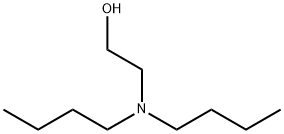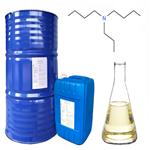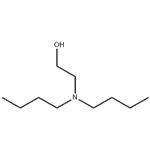2-Di-n-butylaminoethanol is a colorless toyellowish liquid. Faint amine-like odor. Molecularweight = 173.33; Boiling point = 224-232℃; Freezing/Melting point = ,269℃; Flash point = 96℃; Autoignitiontemperature = 240℃. Explosive Limits: LEL = 0.9%;UEL = 5.5%. Hazard Identification (based on NFPA-704 MRating System): Health 3, Flammability 2, Reactivity 0.Solubility in water = 11.6 g/L at 25℃.
2-Di-n-butylaminoethanol is a colorless to
yellowish liquid. Faint amine-like odor.
2-(Dibutylamino)ethanol (DBAE) may be used as a coreactant to enhance the electrochemiluminescence (ECL) of tris(2,2′-bipyridyl)ruthenium(II) [Ru(bpy)32+], employed in the ECL immunoassays and DNA probe assays. DBAE may also be used as a catalyst during the synthesis of protected D-erythro-(2S,3R)-sphingosine.
Dibutylaminoethanol
has found use as a conditioning agent for cellulose
acetate filaments to facilitate textile manufacture, a catalyst
in polyurethane foam manufacture, and an anticorrosion
additive for lubricants and hydraulic fluids, in the manufacture
of emulsifying and dispersing agents, and in the curing of
silicone resins.
2-(DIBUTYLAMINO)ETHANOL is a colorless liquid with a mild fishlike odor. Flash point 200°F. Toxic by ingestion and skin absorption. Used to make other chemicals.
2-(DIBUTYLAMINO)ETHANOL is an aminoalcohol. Amines are chemical bases. They neutralize acids to form salts plus water. These acid-base reactions are exothermic. The amount of heat that is evolved per mole of amine in a neutralization is largely independent of the strength of the amine as a base. Amines may be incompatible with isocyanates, halogenated organics, peroxides, phenols (acidic), epoxides, anhydrides, and acid halides. Flammable gaseous hydrogen is generated by amines in combination with strong reducing agents, such as hydrides.
TOXIC; inhalation, ingestion or skin contact with material may cause severe injury or death. Contact with molten substance may cause severe burns to skin and eyes. Avoid any skin contact. Effects of contact or inhalation may be delayed. Fire may produce irritating, corrosive and/or toxic gases. Runoff from fire control or dilution water may be corrosive and/or toxic and cause pollution.
Combustible material: may burn but does not ignite readily. When heated, vapors may form explosive mixtures with air: indoors, outdoors and sewers explosion hazards. Contact with metals may evolve flammable hydrogen gas. Containers may explode when heated. Runoff may pollute waterways. Substance may be transported in a molten form.
Flammability and Explosibility
Non flammable
Poison by
intraperitoneal route. Moderately toxic by
ingestion and skin contact. A severe eye and
skin irritant. Combustible; can react with
oxidizing materials. To fight fire, use CO2,
dry chemical. When heated to
decomposition it emits toxic fumes of NOx.
See also AMINES and ALCOHOLS
This material is used in organic
synthesis.
If this chemical gets into the eyes, remove anycontact lenses at once and irrigate immediately for at least15 min, occasionally lifting upper and lower lids. Seek medical attention immediately. If this chemical contacts theskin, remove contaminated clothing and wash immediatelywith soap and water. Seek medical attention immediately. Ifthis chemical has been inhaled, remove from exposure,begin rescue breathing (using universal precautions, including resuscitation mask) if breathing has stopped and CPR ifheart action has stopped. Transfer promptly to a medicalfacility. When this chemical has been swallowed, get medical attention. Give large quantities of water and inducevomiting. Do not make an unconscious person vomit.
Color Code—White: Corrosive or Contact Hazard;Store separately in a corrosion-resistant location. Prior toworking with DBAE you should be trained on its properhandling and storage. 2-N-Dibutylaminoethanol must bestored to avoid contact with oxidizers (such as perchlorates,peroxides, permanganates, chlorates, and nitrates) since violent reactions may occur. Sources of ignition, such as smokingand open flames, are prohibited where 2-ndibutylaminoethanol is used, handled, or stored in a mannerthat could create a potential fire or explosion hazard. Wherepossible, automatically pump liquid from drums or otherstorage containers to process containers.
UN2735 Amines, liquid, corrosive, n.o.s, or
Polyamines, liquid, corrosive, n.o.s., Hazard class: 8;
Labels: 8-Corrosive material, Technical Name Required.
Incompatible with oxidizers (chlorates,
nitrates, peroxides, permanganates, perchlorates, chlorine,
bromine, fluorine, etc.); contact may cause fires or explo-
sions. Keep away from alkaline materials, strong bases,
strong acids, oxoacids, and epoxides.
The initial threshold screening level (ITSL) for 2-N-dibutylaminoethanol is 28 μg/m3 based on an annual averaging time.



